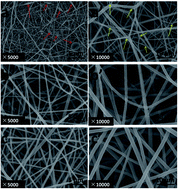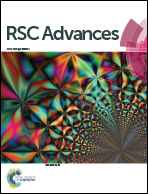Atom efficient thermal and photocuring combined treatments for the synthesis of novel eco-friendly grid-like zein nanofibres
Abstract
We report herein for the first time a novel crosslinking approach for the synthesis of grid-like zein nanofibres with SbQ (styrylpyridinequaternary) realized by a simple electrospinning process followed by thermal treatment and/or UV illumination. The properties of the electrospinning solution, such as viscosity, conductivity, and surface tension, were tested to evaluate the effect of SbQ addition (0 wt%, 10 wt%, 20 wt%) on the electrospinnability of glacial acetic acid solution of zein (25 wt%). The incorporation of SbQ resulted in bead-free nanofibre structures with increased diameter compared to pure zein nanofibres. The FT-IR results indicated that the zein-glacial acidic acid protein solution crosslinked, a phenomenon that can be characterized by two discrete, temporally distinct events: inter-molecular solution crosslinking and intra-fiber crosslinking from the SbQ throughout the nanofibrous mat following photocuring. The SbQ can form intra-fiber bridges, as confirmed by the SEM images; on a macroscopic (gross) scale, the crosslinking manifests itself by the formation of grid-like structures. The thermal properties of the zein nanofibres, however, were minimally improved after the incorporation of SbQ, whereas the cured composite nanofibres demonstrated significantly improved tensile and elongation properties.


 Please wait while we load your content...
Please wait while we load your content...